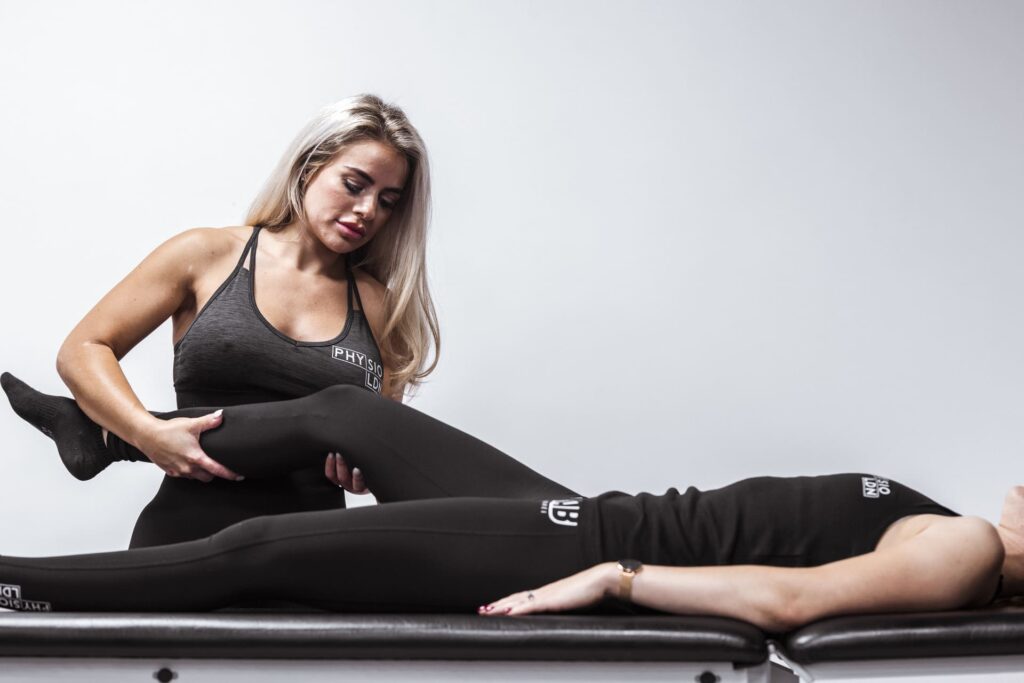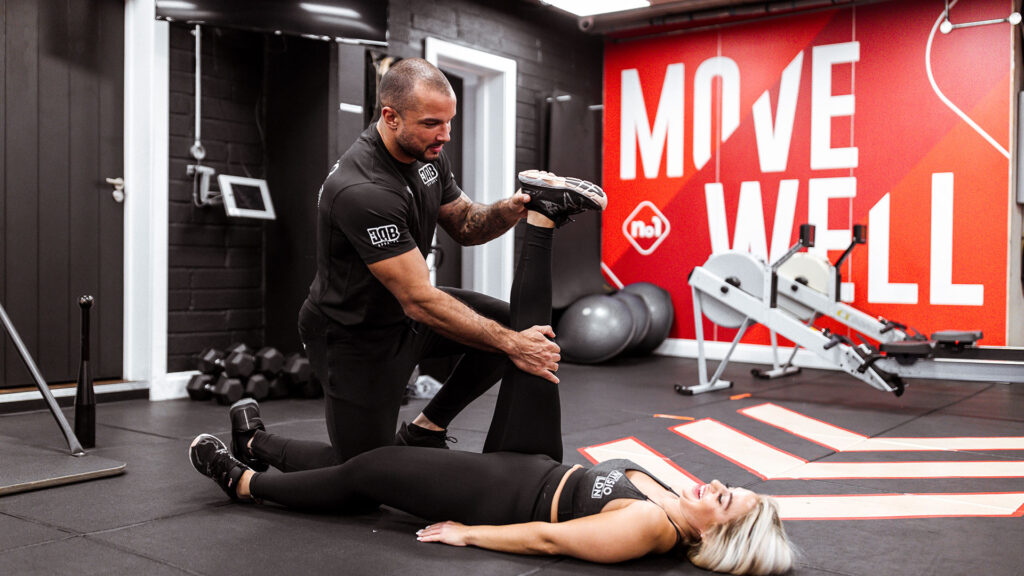Table of Contents
Main Takeaways
- Prevalence: ~5% of adult GP visits.
- Dx path: History → exam (ROM/alignment/stability) → special tests → imaging if needed.
- Likely dx: ≥45 + activity pain + <30 min stiffness → OA; younger/active → patellofemoral pain (~25% lifetime).
- Imaging: X-ray (OA); MRI (ligaments/menisci/cartilage); ultrasound (bursae/tendons/injections).
- AI: OsteoHRNet grades OA on X-rays (~71.7% accuracy).
- PROMs: KOOS/WOMAC guide care.
- Refer if: Persistent/worsening pain, swelling, instability, cannot weight-bear, or function limits.
- London care: One Body LDN physio + rehab.
Knee pain is a common complaint that affects millions worldwide, impacting mobility and quality of life. In fact, approximately 5% of all primary care visits in adults are related to knee pain, underscoring its prevalence and the importance of accurate diagnosis and effective management Evaluation and Treatment of Knee Pain: A Review. Understanding how knee pain is diagnosed is crucial for patients and healthcare providers alike to ensure timely treatment and improved outcomes.If you’re local, exploring knee pain treatment in London can help you access targeted assessment and coordinated follow-up care.
This article explores the diagnostic process for knee pain, common tests and imaging techniques used, and guidance on when to seek expert help. Whether you are experiencing acute discomfort or chronic knee issues, gaining insight into diagnosis can empower you to take the right steps toward recovery.
How Knee Pain is Diagnosed
The diagnosis of knee pain begins with a detailed clinical assessment. Healthcare professionals start by gathering a thorough medical history, including the onset, duration, and nature of the pain, any history of injury, and factors that exacerbate or relieve symptoms. This initial step helps to narrow down potential causes, which range from acute injuries like ligament tears to chronic conditions such as osteoarthritis.

For patients aged 45 years or older presenting with activity-related knee joint pain and minimal morning stiffness (less than 30 minutes), knee osteoarthritis (OA) is the most likely diagnosis Evaluation and Treatment of Knee Pain: A Review. Osteoarthritis is a degenerative joint disease characterized by cartilage breakdown, leading to pain and reduced function. Recognizing this pattern early allows for targeted interventions to manage symptoms and slow progression.
In younger, physically active individuals, patellofemoral pain syndrome is a common cause of knee discomfort, affecting approximately 25% of this population over their lifetime Evaluation and Treatment of Knee Pain: A Review. This condition often presents as anterior knee pain related to activity, especially in sports or repetitive movements.
Following the medical history, a physical examination is conducted to assess the knee’s range of motion, stability, and alignment. Healthcare providers may perform specific tests, such as the McMurray test or the Lachman test, to evaluate for meniscal tears or ligament injuries. These assessments are crucial as they help determine the underlying structural issues contributing to the patient’s pain.
Additionally, imaging studies like X-rays or MRIs may be ordered to visualize the joint and identify any abnormalities, such as bone spurs, cartilage loss, or other degenerative changes.
Partnering with a professional knee pain physiotherapist at this stage can help translate clinical findings into a clear, step-by-step plan for rehabilitation while you await imaging or specialist reviews.
Furthermore, the role of patient-reported outcomes cannot be understated in the diagnostic process. Tools such as the Knee Injury and Osteoarthritis Outcome Score (KOOS) or the Western Ontario and McMaster Universities Osteoarthritis Index (WOMAC) provide valuable insights into the impact of knee pain on a patient’s daily life and function.
These questionnaires help clinicians understand the severity of symptoms from the patient’s perspective, guiding treatment decisions and setting realistic goals for recovery. By integrating clinical assessments with patient-reported outcomes, healthcare professionals can develop a comprehensive and individualized approach to managing knee pain.
Common Tests and Imaging
Following the clinical assessment, various tests and imaging modalities are employed to confirm the diagnosis and assess the severity of knee pathology. Physical examination tests evaluate joint stability, range of motion, swelling, and tenderness. These hands-on assessments help identify ligament injuries, meniscal tears, or signs of inflammation.
Specific tests, such as the Lachman test for anterior cruciate ligament (ACL) integrity or the McMurray test for meniscal tears, are critical in providing immediate insights into the knee’s condition. The clinician’s experience and intuition during these physical assessments can often guide the subsequent imaging decisions. For detail information see the blog knee pain differential diagnosis: causes & tests.
Imaging plays a pivotal role in knee pain diagnosis. X-rays are the first-line imaging technique, particularly useful for detecting osteoarthritis changes such as joint space narrowing and bone spurs. Recent advances in technology have introduced deep learning frameworks like OsteoHRNet, which achieved a multiclass accuracy of 71.74% in assessing knee osteoarthritis severity from X-rays, enhancing diagnostic precision Knee Osteoarthritis Severity Prediction using an Attentive Multi-Scale Deep Convolutional Neural Network.
This innovative approach not only streamlines the diagnostic process but also aids in monitoring disease progression over time, allowing for more tailored treatment plans.
Magnetic Resonance Imaging (MRI) is often used when soft tissue injuries are suspected, providing detailed images of ligaments, tendons, cartilage, and menisci. The ability of MRI to visualize these structures in multiple planes makes it invaluable for diagnosing complex injuries that may not be apparent on X-rays. Additionally, MRI can detect bone marrow edema, a sign of acute injury or inflammation, which can significantly influence treatment decisions. Ultrasound may also be utilized for evaluating soft tissue inflammation or guiding injections.
This dynamic imaging technique allows for real-time assessment of joint movement and can be particularly useful in assessing conditions like bursitis or tendinitis. Moreover, the use of ultrasound in conjunction with therapeutic procedures, such as corticosteroid injections, can enhance the accuracy of treatment delivery, thereby improving patient outcomes.
When to Seek Expert Help
Recognizing when to consult a specialist is vital for effective knee pain management. Persistent knee pain, especially if bilateral or associated with functional limitations, warrants professional evaluation. Studies have identified bilateral knee pain and lower educational levels as factors associated with persistent knee pain at 12-month follow-up, highlighting the need for early intervention Prognostic factors associated with changes in knee pain outcomes.

Individuals experiencing worsening symptoms, such as increasing pain intensity, swelling, instability, or inability to bear weight, should seek expert assessment promptly. Additionally, those with chronic conditions like osteoarthritis benefit from specialized physiotherapy and pain management strategies to maintain mobility and quality of life.
London offers a range of expert physiotherapy clinics specializing in musculoskeletal conditions, including knee pain. Clinics like One Body LDN provide comprehensive assessments and bespoke treatment plans delivered by highly trained physiotherapists with extensive experience in sports injuries, post-operative rehabilitation, and chronic pain management.
Their approach combines manual therapy, exercise prescription, and patient education to address the root cause of knee pain and promote long-term recovery One Body LDN London Physiotherapy.
In addition to physiotherapy, patients may also explore other avenues of treatment that can complement their recovery journey. For instance, acupuncture has gained popularity as an alternative therapy for knee pain relief, with some studies suggesting it can help reduce pain and improve function for those suffering from chronic knee conditions.
Furthermore, nutritional support, including anti-inflammatory diets rich in omega-3 fatty acids and antioxidants, can play a crucial role in managing inflammation and promoting healing. Consulting with a dietitian who specializes in sports nutrition or inflammatory conditions can provide tailored dietary recommendations that align with individual health needs.
Moreover, engaging in community support groups can also be beneficial for those dealing with chronic knee pain. Sharing experiences and coping strategies with others facing similar challenges can foster a sense of belonging and motivation. Many organizations in London host regular meet-ups and workshops focused on pain management techniques, mindfulness practices, and physical activities that are gentle on the knees, such as swimming or cycling.
These resources not only provide valuable information but also encourage a holistic approach to managing knee pain, emphasizing the importance of mental well-being alongside physical health.Tapping into services that offer effective knee pain treatments can round out this approach, helping you move from diagnosis to meaningful, lasting improvement.
FAQ
What are the most common causes of knee pain?
Knee pain can arise from various causes, including osteoarthritis, ligament injuries (such as ACL tears), meniscal damage, patellofemoral pain syndrome, bursitis, and tendonitis. Age, activity level, and previous injuries influence the likelihood of specific conditions. Osteoarthritis, for instance, is a degenerative joint disease that often develops with age, leading to cartilage breakdown and bone-on-bone friction, which can be quite painful. Ligament injuries, particularly those involving the anterior cruciate ligament (ACL), are common in athletes and can result from sudden stops or changes in direction during sports. Understanding the specific cause of knee pain is crucial for effective treatment and management.
How is knee osteoarthritis diagnosed?
Diagnosis involves clinical assessment of symptoms like activity-related pain and morning stiffness, supported by X-ray imaging to detect joint degeneration. Advanced tools like AI-based imaging analysis are enhancing diagnostic accuracy. In addition to X-rays, MRI scans may also be utilized to provide a more detailed view of the soft tissues around the knee, including cartilage and ligaments. Physicians may also perform physical examinations to evaluate the range of motion and stability of the knee joint, which can further assist in confirming the diagnosis and determining the best course of action.
When should I see a physiotherapist for knee pain?
If knee pain persists beyond a few weeks, limits your daily activities, or worsens over time, consulting a physiotherapist is advisable. Early intervention can prevent chronic issues and improve function. Physiotherapists can develop personalized rehabilitation programs that focus on strengthening the muscles around the knee, improving flexibility, and enhancing overall joint stability. They may also employ modalities such as ultrasound therapy or electrical stimulation to alleviate pain and promote healing, making it easier for patients to return to their regular activities.
Can knee pain be managed without surgery?
Many knee pain conditions, especially osteoarthritis and soft tissue injuries, respond well to conservative management including physiotherapy, exercise, pain relief medications, and lifestyle modifications. Weight management plays a significant role, as reducing excess body weight can decrease the stress on knee joints, thereby alleviating pain. Additionally, incorporating low-impact exercises such as swimming or cycling can help maintain joint mobility without exacerbating the condition. Patients are often encouraged to engage in regular physical activity to strengthen the muscles supporting the knee, which can lead to improved function and reduced pain over time.
Are there any new technologies improving knee pain diagnosis?
Yes, deep learning frameworks like OsteoHRNet are being developed to assess osteoarthritis severity from X-rays with high accuracy, aiding clinicians in diagnosis and treatment planning. These technologies utilize algorithms that can analyze vast amounts of imaging data, identifying patterns that may not be visible to the naked eye. Furthermore, wearable technology is also making strides in this field, allowing for real-time monitoring of joint movement and load during daily activities. This data can provide valuable insights into a patient’s condition and help tailor treatment plans more effectively.
How prevalent is knee pain among adults?
Approximately 5% of all primary care visits in adults are related to knee pain, reflecting its common impact on health and mobility. This prevalence can be attributed to a variety of factors, including the aging population and increased participation in physical activities that may lead to injuries. Furthermore, studies indicate that knee pain is more prevalent among individuals with obesity, as excess weight can exacerbate joint stress. Understanding the demographics of knee pain can help healthcare providers develop targeted prevention and treatment strategies, ultimately improving the quality of life for those affected.
Conclusion
Knee pain diagnosis is a multifaceted process involving clinical evaluation, imaging, and sometimes advanced technological tools. Understanding the common causes and diagnostic pathways enables patients to seek timely and appropriate care. With the growing prevalence of knee pain conditions and advancements in diagnostic accuracy, expert physiotherapy services in London offer effective solutions for pain relief and functional restoration.
For those experiencing knee pain, early assessment and intervention can make a significant difference in outcomes. Trusted clinics like One Body LDN combine clinical expertise with patient-centered care to help individuals move better and live pain-free.
Take Control of Your Knee Pain with One Body LDN
Don’t let knee pain hold you back from living your best life. At One Body LDN, voted as the best London physio clinic by thousands, we understand the importance of addressing the root cause of your discomfort. Our award-winning team of physiotherapy experts is dedicated to providing you with a precise diagnosis and a tailored treatment plan that offers instant pain relief. Specializing in musculoskeletal physiotherapy, post-operative care, and sports injuries, we cater to both corporate office workers and athletes. With accolades such as “London Physiotherapy Clinic of the Year” and “Most Trusted Physiotherapy & Sports Massage London Clinic,” you can trust us to deliver exceptional care without overselling treatments. Experience the difference with our expert assessments and rehab plans. Book your free initial assessment at our clinic today and take the first step towards a pain-free life.


